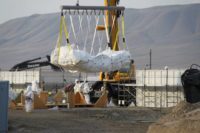The CH2M Hill Cos.-led team that was shortlisted, but not chosen, for an estimated $2-billion contract to support U.S. Antarctica research, is protesting the selection process by the National Science Foundation.
Ralph O. White, managing associate general counsel at the U.S. Government Accountability Office, confirms that a protest was filed to the agency on Jan. 9, challenging the award to Lockheed Martin Corp. and that its merits will be decided by April 18.
In a statement, CH2M Hill Antarctic Support Inc., says the protest is "based on information received from NSF during our debrief on Jan. 5, and careful subequent consideration of that information." The firm says it is "disappointed" with the result of the selection process, which was announced on Dec. 28. Procurement for the contract, which could extend to 12.5 years, took nearly three years, with indications that NSF officials were overwhelmed in its execution.
A spokeswoman for another team led by Houston-based KBR Inc. that shortlisted but missed selection, declined comment on whether it also planned a protest or on details of its team and proposal.
NSF officials could not be reached for comment on how the protest would affect further execution of the contract award.
CH2M Hill Antarctic Support says the contract was a "top priority, and we assembled a highly qualified and committed leadership team...who remain dedicated to serving NSF on this important contract." The firm has not released names of its subcontractors.
The contractor notes its past experience supporting NSF polar research in the Arctic. While not mentioned in its statement, another company unit, CH2M Hill Polar Services, was awarded in September an eight-year, $325-million extension of an agency logistics support contract there, according to published reports.
"We have a unique history of providing excellent cold weather support to NSF in the Arctic," the CH2M Hill Antarctic Support statement says. Englewood, Colo.-based CH2M Hill and its subcontractors have held that NSF contract since 1999. The current team includes subs Polar Field Services, SRI International and a new member, UMIAQ, a native Alaskan-owned firm.
Lockheed Team Revealed
Lockheed Martin Corp. did not release until Jan. 7 the members of its subcontracting team that will perform work to manage construction, building maintenance. site logistics and staff support at three U.S. research stations in Antarctica, McMurdo, Amundsen-Scott South Pole and Palmer
The Bethesda, Md., company announced the award by the National Science Foundation late last month, but the names of subcontractors and team members aren't customarily released prior to the selection and weren't available until days later. Those companies had to endure the prolonged procurement process, too.
"We spent thousands of dollars over nearly three years," says an executive of a subcontractor on one of the losing teams. "Have you ever seen a grown man cry?"
During a selection process that began in 1999, teams that led by AECOM and Fluor Corp. had also pursued the contract.
A joint venture of Computer Sciences Corp. and EG&G Inc., a unit of URS Corp., also had vied for the work, as had a team led by ITT, which had Parsons Corp., as a key subcontractor.
NSF had shortlisted the KBR, CH2M Hill and Lockheed Martin teams in 2010, according to company sources.
Lockheed Martin was set to take over on April 1 from incumbent contractor Raytheon Corp., which has been in the role since 1999. Its contract, originally set to expire in 2009, had been extended though March 2012. Raytheon was understood to have sought work under the new contract, say industry sources, but as a subcontractor on the AECOM team.
An update on Lockheed Martin's website from Celia Lang, the company's project director, says the firm will handle key site functions such as program and technical management, information technology, transportation and logistics and infrastructure and operations.
The spokeswoman says the contract will be managed by Lockheed Martin IS&GS-Civil, a corporate unit that serves "non-defense government agencies, international governments and regulated commercial industries." She says the unit has $4 billion worth of business.
The Lockheed-Martin unit's larger parent had $45 billion in 2010 revenue, she says.
Transportation Sub Is Former Lockheed Unit
One key subcontractor for transportation, infrastructure and logistics is PAE Government Services Inc., a unit of Arlington, Va.-based Pacific Architects and Engineers. The firm is formerly a unit of Lockheed that was sold last year to private equity firm Lindsay Goldberg LLC.
PAE announced in November that it acquired Defense Support Services LLC, a defense logistics and base support services contractor that had been a joint venture of Lockheed Martin and Day & Zimmermann.
PAE New Zealand Ltd. also is listed as project sub, along with GHG Corp. for IT and communications; Damco, a unit of A.P. Moller-Maersk Group for transportation; the University of Texas for medical services; and others for waste management, security, and other services.
Under the new contract, Lockheed says it will "implement a cost-effective, streamlined infrastructure for managing work stations and medical facilities, research vessels, construction projects and remote sites in and around Antarctica." The company adds that it will modernize transportation technologies for scientists, staff and supplies to and from the region.
"Lockheed Martin is a long-standing provider of infrastructure support and affordable solutions for nearly 100 years," says the spokeswoman. She says there are about 3,000 staffers in Antarctica, including researchers, government employees and support personnel, but she did not specify the number of contractor personnel.
Bart Bridwell, an NSF contracting official, estimates that there is about $270 million in "major construction and other similar projects over the maximum award term" at three stations maintained in Antarctica. Work may also support science deployments outside those stations, as needed by scientific missions, he adds.
Bridwell adds that NSF's evaluation of proposals addressed "technical merit, past performance record, cost and commitment to small business subcontracting. "Technical merit was substantially more important that the other factors identified," he says.
Noting NSF's struggle to award the contract, Bridwell said: "I'm afraid federal acquisition is not for the faint of heart. This is a large contract with a large amount of data to review, activity that took much longer than NSF anticipated when we initially put a schedule together."
Seeking to raise their profiles to NSF evaluators, several teams had touted their capabilities on large billboards placed strategically at the subway station adjacent to the agency’s Arlington, Va., headquarters and on train cars.




